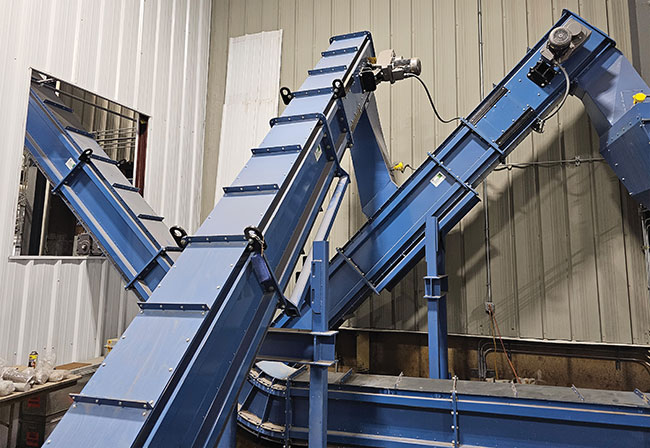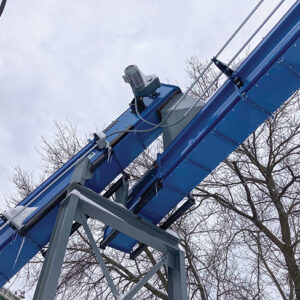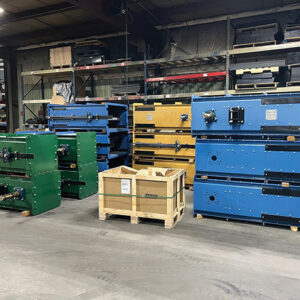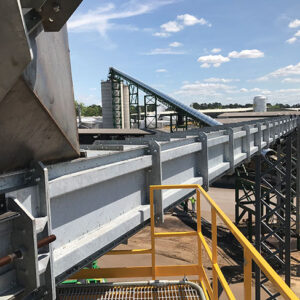
Conveyors: a key piece of the puzzle
September 5, 2023
By Biomass Engineering & Equipment
Brought to you by Biomass Engineering & Equipment
 S-Series SMART Conveyors handle wood waste at Kretz Lumber.
All photos courtesy of Biomass Engineering & Equipment.
S-Series SMART Conveyors handle wood waste at Kretz Lumber.
All photos courtesy of Biomass Engineering & Equipment. When it comes to designing or retrofitting a biomass operation, conveyors may seem like a small piece of the puzzle. But, they play a very big role in keeping biomass operations running safely and smoothly.
Dane Floyd, president and CEO of Biomass Engineering & Equipment (BE&E), knows how important it is for conveyors to run efficiently and smoothly. Before founding the company, he spent decades in the industry building plants.
“Waste handling seemed to always take a second or third seat when someone was designing a plant,” he says. “But, it becomes a bottleneck to operating an efficient plant. You can’t just pile up waste forever – you have to deal with it [and] it needs to be part of the overall flow.”
Conveying problems
There are several drawbacks to traditional drag conveyors that can make them inefficient, costly and dangerous.
For example, they can be difficult and time-consuming to install, requiring several days of downtime and a lot of man-hours. The cost of installing traditional conveyors also adds up quickly since crews need to install several steel supports or trusses, which involves pouring concrete underneath them and more engineering design hours.
Most conventional conveyors also create a lot of internal friction. They typically have steel chains that are dragged across a steel bottom pan, which leads to increased friction and wear and requires a higher level of horsepower to operate, explains Paul Kalil, technical sales and projects lead at BE&E.
As a result, these conveyors often need to be rebuilt, increasing a plant’s operational costs massively, he says.
Steel on steel friction also means there’s a greater risk of combustible dust explosions or fires.
“Drag chain conveyors, by their design, will have fine wood particles suspended in a cloud and mixed with oxygen during their normal operation. Therefore, they are an inherent combustible dust risk,” explains Jay Juvenal, sales engineering manager at CV Technology.
“Additionally, drag chain conveyors can have a higher risk profile because they have a higher propensity for having ignition sources introduced. These ignition sources can be internally generated – for example, bearings can become overheated – or externally introduced via hammer mills or pellet coolers. Extensive loss history and empirical evidence has proven all of these scenarios happen in real-world installations,” he adds.
In fact, according to the 2021 Combustible Dust Incident Report by Dust Safety Science, 25 per cent of all combustible dust fires and explosions recorded in 2021 occurred in the wood products industry. There were 35 fires and 14 explosions, resulting in 32 injuries and six fatalities.
While the majority of combustible dust incidents included in the report involved storage silos, dryers and dust collectors, 7.4 per cent involved elevators/conveyors.
A modular approach
After seeing these issues first-hand in the industry, Floyd saw an opportunity to improve upon the design of conventional drag conveyors and address these problems. Enter SMART Conveyors – modular drag conveyors that can be customized to suit many plants’ needs.
The conveyors are fully enclosed, designed in standard 60-inch sections consisting of three 20-inch top panels and three 20-inch bottom panels that are symmetrical. The pieces can be bolted together in any configuration, like LEGOs, and assembled on-site, which provides a lot of flexibility compared to traditional drag conveyors, Floyd says.
“They are designed to last for 30 years,” he says. “In a 30-year lifespan it’s pretty likely that something is going to change in the application. So, if you need to add a gate [or] an inlet or an outlet [for instance], it’s as simple as un-bolting a top panel and bolting in an inlet chute.”
The conveyors are also self-supporting, only needing supports every 40 feet, unlike most conventional conveyors. According to Floyd, this greatly reduces the time and cost of the installation. This modular approach also means the conveyors are maintenance-friendly. Since all of the components are bolted or riveted together, there’s no need for cutting, welding or hot work permits, explains Cory Frashefski, technical sales and projects lead for BE&E.
“When you have a sealed conveyor system, the hot work requires that a conveyor be blown out and cleaned out before any work can continue. By eliminating that, we’ve really reduced the maintenance and downtime required to get the conveyor back up and running,” he says.
Less friction, less dust
SMART Conveyors also help reduce plants’ operational costs because they are designed with friction in mind, using roller chains in a dual chain system connected by high-density polyethylene paddles, Frashefski says.
“Our paddles are not physically touching the bottom pan or side walls of the conveyor, so our only friction is our chain, which is gliding on UHMW [ultra-high molecular weight polyethylene] strips,” he explains.
As a result, SMART Conveyors require less horsepower than traditional drag conveyors.
Less friction also means less heat, which lowers the chance of a combustible dust incident – a key safety issue for any biomass operation.
“Working with the dust properties, we establish the rating for that particular environment and that particular dust with the customer, and then we work with folks like CV Technology, who design these types of systems, [to] put the minimum necessary number of panels on [the conveyor] to maintain the safety level that is required,” Kalil explains, noting the conveyors are fully compliant with all National Fire Protection Association (NFPA) regulations concerning dust safety.
“If the properties of the dust change and it becomes a bigger issue – for example, the KST value goes up – you can very easily add additional panels after the fact because it’s all modularized and we have a standard interface to the conveyor for those panels,” he adds.
Bolt-on explosion vents, explosion panels and sprinkler or deluge systems can also be mounted to the top of the conveyor to address dust safety requirements.
Screen inspection windows – steel screens that can be opened to inspect the inside of the conveyor while it’s operating – also help maintain a dust-tight environment and protect workers from additional risks and hazards.
Prioritizing safety
SMART Conveyors are also designed to mitigate other safety risks.
Although the conveyors are fully enclosed, all preventative maintenance can be done without opening them and exposing people to hazards.
For example, the roller chains can be tensioned on the outside of the conveyor while it continues running. Shaft-mounted gear motors also eliminate the need for additional guarding and cages, Kalil says.
“There are no pinch points, there are no guards required, because the design is inherently safe,” he explains. “It’s not something you come across after the fact and then have to spend an extra $5,000 or $10,000 putting guards up to protect your employees from what is actually a very dangerous piece of equipment.”
“Safety is the primary reason why proper conveyance and proper machinery is really [important],” Frashefski adds. “We’re still seeing and responding to mill fires caused by explosive dust or machinery fires […]. Our mission is to mitigate and eliminate these risks.”
As part of that mission, BE&E works with customers to troubleshoot any issues and improve the conveyors’ safety and reliability.
“Once we’ve worked through an issue and found a solution, we commonly take that knowledge and apply it to the next revisions or designs,” Frashefski says. “So, we’re continuing to learn and grow.”
![]() For more information, please visit beande.com
For more information, please visit beande.com
Print this page


